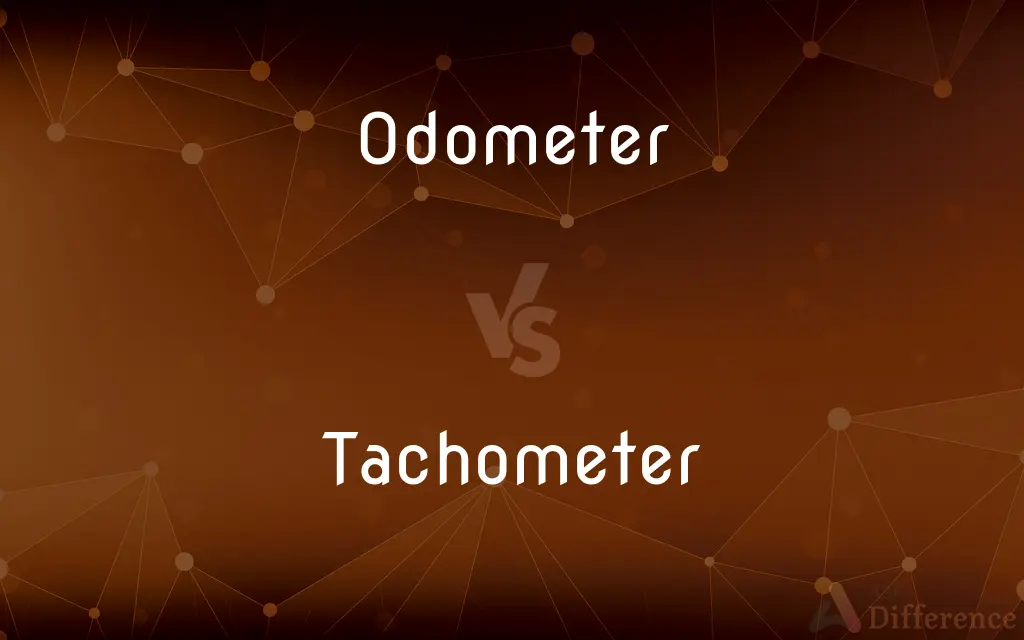Odometer vs. Tachometer — What's the Difference?
By Tayyaba Rehman & Maham Liaqat — Updated on March 10, 2024
An odometer measures the total distance a vehicle has traveled, while a tachometer displays the engine's current RPM (revolutions per minute).

Difference Between Odometer and Tachometer
Table of Contents
ADVERTISEMENT
Key Differences
An odometer is a crucial instrument found in vehicles that records the total miles or kilometers the vehicle has traveled since its manufacturing. This helps in determining the vehicle's age and maintenance schedule. On the other hand, a tachometer measures the engine's speed in revolutions per minute (RPM), which assists drivers in optimizing fuel efficiency and preventing engine over-revving.
While the primary function of an odometer is to track the cumulative distance covered, providing insights into vehicle wear and potential resale value, a tachometer provides real-time data on engine speed. This information is vital for manual transmission vehicles, where it guides the driver on when to shift gears.
Odometers are usually designed to work throughout the lifespan of the vehicle and rarely need resetting, except in the case of maintenance or instrument panel replacement. Conversely, tachometers are more about immediate engine performance, displaying changes in engine speed as they happen.
The readings from an odometer play a critical role in scheduling maintenance, determining a vehicle's value, and ensuring compliance with lease agreements by tracking mileage. Whereas the tachometer's readings are crucial for driving dynamics, they help in achieving better fuel efficiency and preventing engine damage due to high RPMs.
Odometers and tachometers, while both providing essential information about a vehicle's operation, serve distinct purposes. The former is indispensable for long-term vehicle care and management, while the latter is essential for day-to-day operation and maintaining engine health.
ADVERTISEMENT
Comparison Chart
Purpose
Measures total distance traveled by a vehicle.
Measures engine speed in RPM.
Significance
Helps in maintenance scheduling and assessing vehicle's wear.
Guides in optimizing engine performance and fuel efficiency.
Display Unit
Miles or kilometers.
Revolutions per minute (RPM).
Usage
Used for determining vehicle's mileage for resale, maintenance, and lease agreements.
Used to monitor and adjust engine speed, especially in manual transmission vehicles.
Maintenance Impact
Crucial for long-term vehicle care and management.
Essential for preventing engine damage and ensuring efficient operation.
Compare with Definitions
Odometer
Integral for vehicle maintenance schedules.
Based on the odometer reading, it's time for your vehicle's service.
Tachometer
An instrument measuring the rotation speed of an engine.
The tachometer's needle hovered at 3000 RPM while cruising.
Odometer
Reflects the vehicle's overall wear and tear.
A high odometer reading can indicate significant wear.
Tachometer
Indicates immediate engine performance.
A sudden drop in the tachometer reading could signal engine trouble.
Odometer
A device for measuring the distance traveled by a vehicle.
The car's odometer showed 120,000 miles, indicating its extensive use.
Tachometer
Helps in optimizing gear shifts in manual transmissions.
He shifted gears as the tachometer reached the redline.
Odometer
Important for assessing a used vehicle's value.
The lower the odometer reading, the higher the car's value.
Tachometer
Prevents engine over-revving by providing RPM data.
Watching the tachometer helps avoid damaging the engine.
Odometer
Used in mileage calculations for lease agreements.
The lease agreement limits yearly mileage, as tracked by the odometer.
Tachometer
Essential for maintaining fuel efficiency.
The tachometer reading indicates the most fuel-efficient engine speed.
Odometer
An odometer or odograph is an instrument used for measuring the distance traveled by a vehicle, such as a bicycle or car. The device may be electronic, mechanical, or a combination of the two (electromechanical).
Tachometer
A tachometer (revolution-counter, tach, rev-counter, RPM gauge) is an instrument measuring the rotation speed of a shaft or disk, as in a motor or other machine. The device usually displays the revolutions per minute (RPM) on a calibrated analogue dial, but digital displays are increasingly common.
Odometer
An instrument for measuring the distance travelled by a wheeled vehicle.
Tachometer
An instrument which measures the working speed of an engine (especially in a road vehicle), typically in revolutions per minute.
Odometer
An instrument that indicates distance traveled by a vehicle.
Tachometer
An instrument used to measure the rotations per minute of a rotating shaft.
Odometer
An instrument, usually embedded within the speedometer of a vehicle, that measures the distance the vehicle has traveled since production.
Tachometer
A device for measuring the revolutions per minute (RPMs) of a revolving shaft, as with the driveshaft of an automobile.
Odometer
A wheel used by surveyors, which registers distance traveled.
Tachometer
An instrument for measuring the velocity, or indicating changes in the velocity, of a moving body or substance.
Odometer
An instrument attached to a vehicle or connected, as by a flexible cable, to the wheel of a vehicle, which measures the distance traversed.
Tachometer
An instrument for measuring the velocity of running water in a river or canal, consisting of a wheel with inclined vanes, which is turned by the current. The rotations of the wheel are recorded by clockwork.
Odometer
A hodometer.
Tachometer
An instrument for showing at any moment the speed of a revolving shaft, consisting of a delicate revolving conical pendulum which is driven by the shaft, and the action of which by change of speed moves a pointer which indicates the speed on a graduated dial.
Odometer
A meter that shows mileage traversed
Tachometer
Measuring instrument for indicating speed of rotation
Common Curiosities
Is the odometer reading important for used car valuation?
Yes, the odometer reading significantly impacts a used vehicle's value, indicating its wear and usage.
What does an odometer measure?
An odometer measures the total distance a vehicle has traveled.
How does a tachometer benefit drivers?
It provides engine speed information, helping drivers optimize fuel efficiency and prevent engine over-revving.
Can an odometer be reset?
Typically, odometers are not reset but may be replaced or corrected during maintenance.
What does a high RPM on a tachometer indicate?
High RPM indicates the engine is running at a high speed, which may be necessary for acceleration or could indicate unnecessary over-revving.
What happens if a tachometer is ignored?
Ignoring the tachometer can lead to inefficient driving, higher fuel consumption, and engine damage.
Do all vehicles have both an odometer and a tachometer?
Most modern vehicles have both, but some older or basic models might lack a tachometer.
How often should I check my vehicle's odometer?
Regularly, to stay informed about maintenance schedules and monitor vehicle usage.
What's the significance of the red zone on a tachometer?
The red zone indicates a danger area where engine speed is too high, risking damage.
How do odometers differ from trip meters?
Odometers measure the vehicle's total distance since manufacturing, while trip meters track distance for specific journeys.
Can a digital odometer be tampered with?
Tampering with digital odometers is illegal, but not impossible, requiring specialized knowledge and tools.
Does resetting an odometer affect the vehicle's value?
Yes, illegally resetting an odometer to falsely lower a vehicle's mileage is fraud and can severely affect its value and legality.
Why is RPM information important?
RPM information is crucial for managing engine efficiency, performance, and longevity.
Can driving habits influence the readings on a tachometer and odometer?
Driving habits directly affect tachometer readings (RPM) and indirectly influence odometer readings through vehicle usage and wear.
What maintenance is associated with an odometer and tachometer?
Both require minimal maintenance but are critical for diagnostics and ensuring accurate vehicle operation and management.
Share Your Discovery

Previous Comparison
Particulars vs. Generalities
Next Comparison
Ware vs. TareAuthor Spotlight
Written by
Tayyaba RehmanTayyaba Rehman is a distinguished writer, currently serving as a primary contributor to askdifference.com. As a researcher in semantics and etymology, Tayyaba's passion for the complexity of languages and their distinctions has found a perfect home on the platform. Tayyaba delves into the intricacies of language, distinguishing between commonly confused words and phrases, thereby providing clarity for readers worldwide.
Co-written by
Maham Liaqat















































